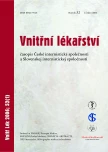The influence of targeted intervention on the incidence of risk factors of cardiovascular diseases at medical staff
Authors:
E. Sovová 1; M. Kaletová 1; M. Nakládalová 1; J. Lukl 1; I. Benušová 1; P. Doupalová 1
Authors‘ workplace:
I. interní klinika Lékařské fakulty UP a FN, Olomouc, přednosta prof. MUDr. Jan Lukl, CSc.
1; Klinika pracovního lékařství Lékařské fakulty UP a FN, Olomouc, přednosta MUDr. Marie Nakládalová, Ph. D.
2
Published in:
Vnitř Lék 2006; 52(1): 21-25
Category:
Original Contributions
Overview
Introduction:
The work addresses the targeted intervention of cardiovascular diseases at medical staff.
Set and methodics:
During 2002–2004 years, within the scope of preventive examination, there was made targeted prevention of risk factors of cardiovascular diseases (CVD) at the big hospital employees at the Centre of preventive care of employees and in the department of preventive cardiology of Ist Internal Clinic of LF UP and FN Olomouc. According to the effective tables, there was stated a CVD risk of these employees. The employees received a personal individual letter which informed them of the level of CVD risk and proposed a targeted intervention of risk factors. The part of the set – 427 employees of the average age of 38.93 years (SD 11.39), 69 men (M) of the average age of 40 years (SD 12.47) and 358 women (F) of the average age of 38.7 years (SD 11.18) was examined another time during 2004–2005 years. The methodics of second examination was the same as at the first examination, only the questionnaire was complemented by the questions related to the knowledge of the CVD risk stated at previous examination.
Results:
There occurred statistically significant decrease of LDL cholesterol in the set (from 2.87 mmol/l to 1.23 mmol/l, p < 0.0001) and BMI decrease (from 24.35 to 24.16, p < 0.05) and at the same time statistically significant increase of total cholesterol (from 5.09 mmol/l to 5.27 mmol/l, p < 0.05) and triglycerides (from 1.27 mmol/l to 3.01 mmol/l, p < 0.0001). There was no significant change in other RFs (BP, WHR, HDL cholesterol, moving activity). The influence on RF of smoking was statistically significant (23 employees quitted smoking, 10 employees started, p < 0.05). 53 F (14.80 %) and 3 M (4.34 %) know their cardiovascular risk, 235 F (65.64 %) and 53 M (76.81 %) do not know their cardiovascular risk.
Conclusion:
The work approved the influence of targeted intervention on the incidence of cardiovascular diseases risk factors and at the same time low level of knowledge of one’s own individual risk, despite of targeted intervention.
Key words:
primary prevention of cardiovascular diseases – risk factors – medical staff
Sources
1. Baier CA, Grodzin CJ, Port D et al. Coronary risk factors behavior change in hospital personnel following a screening program. Am J Prev Med 1992; 8: 115-122.
2. Berra K. The effect of lifestyle interventions on quality and patients satisfaction with health and health care. J Cardiovac Nurs 2003; 18: 319-325.
3. Brázdová Z, Fiala J. Efekt nefarmakologické intervence na snížení hladiny plazmatického cholesterolu. Vnitř Lék 2000; 46: 559-564.
4. Cífková R et al. Prevence ischemické choroby srdeční v dospělém věku. Cor Vasa 2000; 42(Kardio): 225-234.
5. Cífková R, Škodová Z. Dlouhodobé trendy hlavních rizikových faktorů kardiovaskulárních onemocnění v české populaci. Čas Lék Čes 2004; 143: 219-226.
6. Fiala J. Preventivní projekt realizovaný metodou individuálního hodnocení rizika a intervence v rámci lékařských fakult. Hygiena 2001; 47: 123-130.
7. Garcia AF, Galan MA, Taix FM et al. Effectiveness of cardiovascular prevention in primary care. Aten Primaria 2001; 28: 642-647.
8. Gysan DB, Latsch J, Stutzer H et al. The PreFord Study. A prospective cohort study to evaluate the risk of a cardiovascular event (overall-colective) as well as a prospective, randomized, controlled, multicentre clinical intervention study (high-risk-collective) on primary prevention of cardiovascular diseasee in the Ford Motor Company employees in Germany. Z Kardiol 2004; 93: 131-136.
9. Hlávková J, Blažková V. Zdravotní rizika kardiovaskulárních onemocnění učitelů. Pracov Lék 1999; 51: 255-260.
10. Hromadová D. Modifikované faktory s prevenci kardiovaskulárních onemocnění. Hygiena 2003; 48: 153-162.
11. Kardas P. Nevstřícnost a nespolupráce pacientů - mýty a fakta. Čas Lék Čes 2004; 143: 556-559.
12. Lauter J. My Heart fighting cardiovascular disease by preventive lifestyle and early diagnosis. Stud Health Technol Inform 2004; 108: 36-42.
13. Mádlová I, Mádle A, Bílek M. Kouření sester českých nemocnic. Hygiena 2001; 46: 24-32.
14. Mayer O jr, Rosolová H, Wiendl M et al. Změny rizikového profilu a vývoj hypertenze v plzeňské populaci mezi lety 1987 - 1989 a 1995 - 1996. Vnitř Lék 2001; 47: 454-459.
15. Olšovský J. Obezita a diabetes. Vnitř Lék 2003; 49: 956-959.
16. Qureshi AI, Suri MF, Kirmani JF et al. The relative impact of inadequate primary and secondary prevention on cardiovascular mortality in the United States. Stroke 2004; 35: 2346-2350.
17. Reissigová J, Tomečková M. Intervence rizikových faktorů aterosklerosy a kardiovaskulární úmrtnost. Cor Vasa 2003; 45: 249-255.
18. Soška V. Dyslipidémie a metabolický syndrom. Vnitř Lék 2003; 49: 943-947.
19. Van Steenkiste B, van der Weijden T, Timmermans D et al. Patients ideas, fears and expectations of their coronary risk: barriers for primary prevention. Patient Educ Couns 2004; 55: 301-307.
20. Národní vaskulární program. Cor Vasa 2001; 43(Kardio).
Labels
Diabetology Endocrinology Internal medicineArticle was published in
Internal Medicine

2006 Issue 1
Most read in this issue
- AIP – Atherogenic index of plasma like significant predictor of cardiovascular risk: from research to practice
- The volumes of the thyroid gland in adults aged 18-65 years in Czech republic - determination of the norms
-
Diagnostika a léčba jaterní encefalopatie
Doporučený postup vypracovaný skupinou pro portální hypertenzi při České hepatologické společnosti České lékařské společnosti J. E. Purkyně a schválený výborem České hepatologické společnosti České lékařské společnosti J. E. Purkyně - Antiphospholipid syndrome – the description of two cases
